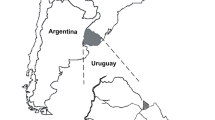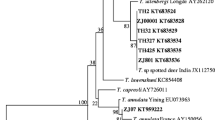Abstract
The potential role of roe deer as a sylvatic reservoir of Bartonella in north-west Poland has been assessed. In addition, ticks infesting roe deer were screened to assess their role as a vector and reservoir of Bartonella. Blood and tissue samples of 72 animals from north-western Poland were PCR-screened. Bartonella DNA was detected by using primers complementary to the intergenic spacer between the 16S and 23S rRNA genes, which is used for identification of over a dozen species of this genus. Products of three different sizes were detected: 230 and 290 bp, representative of two strains of Bartonella capreoli, and 190 bp, identified as Bartonella bovis. All the three amplicons were detected in the blood, spleen and liver from the roe deer. All samples from the heart, lungs and kidneys were PCR negative. In ticks (Ixodes ricinus), only the 290 bp fragment from B. capreoli was present. Generally, Bartonella infection rate in Capreolus capreolus amounted to 27.6% of the roe deer, but it was much higher during winter (62%) than in spring (6.9%). The results show that the roe deer may be a reservoir for B. capreoli and B. bovis. The infection detected in I. ricinus ticks (7.7%) suggests that ticks may act as a Bartonella reservoir and vector.

Similar content being viewed by others
References
Bajer A, Pawełczyk A, Behnke JM, Gilbert FS, Siński E (2001) Factors affecting the component community structure of haemoparasites in bank voles (Clethrionomys glareolus) from the Mazury Lake District region of Poland. Parasitology 122:43–54
Bermond D, Boulouis HJ, Heller R, Van Laere G, Monteil H, Chomel BB, Sander A, Dehio C, Piemont Y (2002) Bartonella bovis Bermond et al. sp. nov. and Bartonella capreoli sp. nov., isolated from European ruminants. Int J Syst Evol Microbiol 52:383–390
Breischwerdt EB, Kordick DL (2000) Bartonella infections in animals: carriership, potential reservoir, pathogenicity, and zoonotic potential for human infection. Clin Microbiol Rev 13:428–438
Britles RJ, Laycock G, Kenny MJ, Shaw SE, Day MJ (2002) Prevalence of Bartonella species causing bacteriaemia in domesticated and companion animals in the United Kingdom. Vet Rec 151:225–229
Chang CC, Yamamoto K, Chomel B, Kasten RW, Simpson DC, Smith CR, Kramer VL (1999) Seroepidemiology of Bartonella vinsonii subsp. berkhoffii infection in California coyotes, 1994—1998. Emerg Infect Dis 5:711–715
Chang CC, Chomel B, Kasten RW, Heller R, Kocan KM, Ueno H, Yamamoto K, Bleich VC, Pierce BM, Gonzales BJ, Swift PK, Boyce WM, Jang SS, Boulouis HJ, Piemont Y (2000) Bartonella spp. isolated from wild and domestic ruminants in north America. Emerg Infect Dis 6:306–311
Chang CC, Chomel B, Kasten RW, Romano V, Tietze N (2001) Molecular evidence of Bartonella spp. in questing adult Ixodes pacificus ticks in California. J Clin Microbiol 39:1221–1226
Dehio C. (2004) Molecular and cellular basis of bartonella pathogenesis. Ann Rev Microbiol 58:365–390
Dehio C, Lanz C, Pohl R, Behrens P, Bermond D, Piemont Y, Sander A. (2001) Bartonella schoenbuchii sp. nov., isolated from the blood of deer. Int J Syst Evol Microbiol 51:1557–1565
Guy EC, Stanek G (1991) Detection of Borrelia burgdorferi in patient with Lyme disease by the polymerase chain reaction. J Clin Pathol 44:610–611
Heller R, Artois M, Xemar V, de Briel D, Gehin H, Jaulhac B, Monteil H, Piemont Y (1997) Prevalence of Bartonella hensele and Bartonelle clarridgeiae in strain cats. J Clin Microbiol 35:1327–1331
Holmberg M, Mills JN, McGill S, Benjamin G, Ellis BA (2003) Bartonella infection in sylvatic small mammals of central Sweden. Epidemiol Infect 130:149–157
Hozer J, Korol M, Korol J, Talaga L, Witek M (1998) Statistic, statistical description. University of Szczecin, Szczecin
Jensen W, Fall MZ, Rooney J, Kordick DL, Breitschwerdt AB (2000) Rapid identification and differentiation of Bartonella species using a single-step PCR assay. J Clin Microbiol 38:1717–1722
Kordick DL, Breitschwerdt EB (1997) Relapsing bacteremia after blood transmission of Bartonella henselae to cats. Am J Vet Res 58:492–497
Kordick DL, Wilson KH, Sexton DJ, Hadfield TL, Berkhoff HA, Breitschwerdt EB (1995) Prolonged Bartonella bacteremia in cats associated with cat-scratch disease patients. J Clin Microbiol 33:3245–3251
Kordick DL, Hilyard EJ, Hadfield TL, Wilson KH, Steigerwalt AG, Brenner DJ, Breitschwerdt AB (1997) Bartonella clarridgeiae, a newly recognized zoonotic pathogen causing inoculation papules, fever, and lymphadenopathy (cat scratch disease). J Clin Microbiol 35:1813–1818
Kordick SK, Breitschwerdt EB, Hegarty BC, Southwick KL, Colitz CM, Hancock SI, Bradley JM, Rumbough R, McPherson JT, MacCormack JN (1999) Coinfection with multiple tick-borne pathogens in a walker hound kennel in north Carolina. J Clin Microbiol 37:2631–2638
Maillard R, Vayssier-Taussat M, Bouillin C, Gandoin C, Halos L, Chomel B, Piemont Y, Boulouis HJ (2004) Identification of Bartonella strains isolated from wild and domestic ruminants by a single-step PCR analysis of the 16S-23S intergenic spacer region. Vet Microbiol 1:63–69
Michau TM, Breitschwerdt EB, Gilger BC, Davidson MG (2003) Bartonella vinsonii subspecies berkhoffi as a possible cause of anterior uveitis and choroiditis in a dog. Vet Ophthalmol 6:299–304
Pawelczyk A, Bajer A, Behnke JM., Gilbert FS, Siński E (2004) Factors affecting the component community structure of haemoparasites in common voles (Microtus arvalis) from the Mazury Lake District region of Poland. Parasitol Res 92:270–284
Rolain JM, Rousset E, La Scola B, Duquesnel R, Raoult D (2003) Bartonella schoenbuchensis isolated from the blood of a French cow. Ann N Y Acad Sci 990:236–238
Sanogo YO, Zeaiter Z, Caruso G, Merola F, Shpynov S, Brouqui P, Raoult D (2003) Bartonella henselae in Ixodes ricinus ticks (Acari: Ixodida) removed from humans, Belluno Province, Italy. Emerg Infect Dis 9:329–332
Schouls LM, Van De Pol I, Rijpkema SG, Schot CS (1999) Detection and identification of Ehrlichia, Borrelia burgdorferi sensu lato, and Bartonella species in Dutch Ixodes ricinus ticks. J Clin Microbiol 37:2215–2222
Sinski E. (2004) Pasożyty krwi u wolno żyjcych gryzoni (Bartonella sp., Mycoplasma haemomuris): prewalencja zakażenia i wektory transmisji. In: Buczek A, Błaszak C (eds) Stawonogi—interakcje pasożyt—żywiciel. Liber, Lublin, pp 229–235
Skotarczak B, Adamska M. Detection of DNA of Anaplasma phagocytophilum in blood, spleen and liver of roe deer (Capreolus capreolus) from northwestern Poland. Acta Vet Brno (in press)
Tuttle AD, Birkenheuer AJ, Juopperi T, Levy MG, Breitschwerdt EB (2003) Concurrent bartonellosis and babesiosis in a dog with persistent thrombocytopenia (see also pp 1280–1281). J Am Vet Med Assoc 223:1306–1310
Ying B, Kosoy MY, Maupin GO, Tsuchiya KR, Gage KL (2002) Genetic and ecologic characteristics of Bartonella communities in rodents in southern China. Am J Trop Med Hyg 66:622–627
Author information
Authors and Affiliations
Corresponding author
Rights and permissions
About this article
Cite this article
Skotarczak, B., Adamska, M. Detection of Bartonella DNA in roe deer (Capreolus capreolus) and in ticks removed from deer. Eur J Wildl Res 51, 287–290 (2005). https://doi.org/10.1007/s10344-005-0112-1
Received:
Accepted:
Published:
Issue Date:
DOI: https://doi.org/10.1007/s10344-005-0112-1




